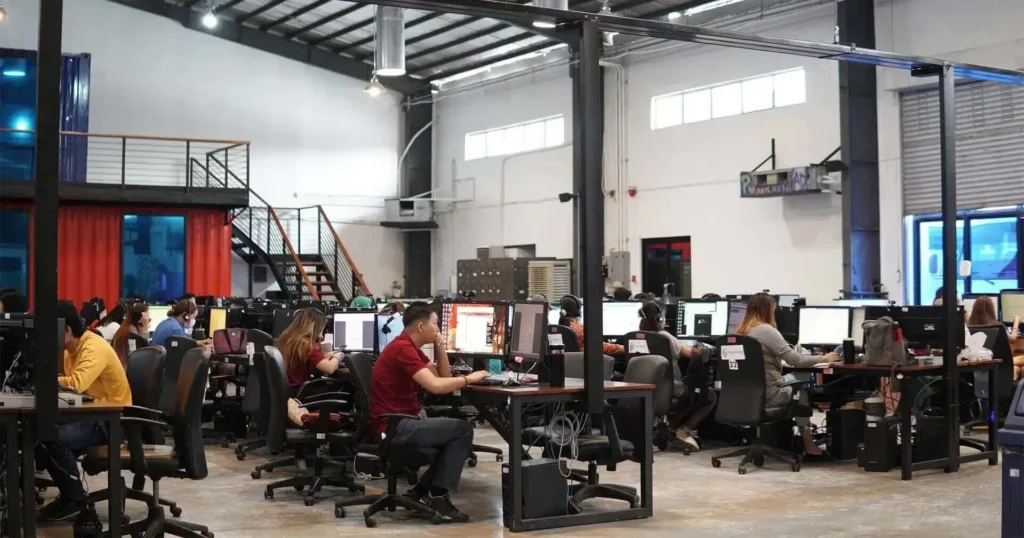The design of your workspace is an essential aspect of creating a positive impression on your ideal clients and fostering a strong connection with them. A thoughtfully designed space can boost productivity and creativity while also contributing to overall client satisfaction. An intentionally designed workspace shows your company’s commitment to delivering the highest standards to your clients and employees. Moreover, this demonstrates the value you put into understanding your client’s needs and preferences.
To create a workspace that attracts and retains the right clients, it’s essential to take a holistic approach that encompasses several key factors. Help your business secure a satisfactory and lasting partnership as we delve into the key factors of designing a workspace that resonates with your ideal clients.

Defining your brand identity is the cornerstone of attracting the right clients who align with your values, vision, and mission. Begin by introspectively examining your company’s mission, core principles, and the unique impact you aim to make in your industry. Identify the pain points you wish to address and the solutions you provide to your target audience.
By creating a well-defined brand identity that clearly communicates your company’s purpose, values, and the problems you aim to solve, you can effectively attract clients who resonate with your brand and are more likely to become loyal advocates for your business. This process will not only help you stand out in the market but also create a strong foundation for lasting and meaningful client relationships.
Prioritizing comfort and functionality is paramount when designing a workspace that appeals to clients and boosts productivity. To achieve this, invest in ergonomic furniture that promotes proper posture and comfort for both clients and employees. This reduces the risk of strain and fatigue. By thoughtfully arranging your workspace to maximize space utilization, you facilitate smooth client interactions and promote a more efficient work environment. By focusing on these elements, you can design a workspace that not only caters to the needs of your clients but also promotes the well-being and efficiency of your team.

Creating an inviting atmosphere is essential for making clients feel welcome and valued, ultimately leaving a lasting impression. Add personal touches to your workspace, such as artwork or decorative items that reflect your brand’s personality and values. Thoughtful lighting and comfortable seating can also contribute to a warm and inviting atmosphere. By carefully curating your workspace, you can create an environment that not only resonates with clients but also encourages positive associations with your brand.
Showcasing your expertise and success is essential in building trust and credibility with your clients. Displaying awards, certifications, and testimonials not only highlights your achievements but also instills confidence in your abilities. Featuring a portfolio of your work or case studies allows clients to see tangible examples of your success, and further solidifies your reputation.
Additionally, creating a designated space for client consultations or meetings demonstrates your commitment to privacy and professionalism, fostering an environment where clients can feel comfortable discussing their needs and concerns.

Maintaining a clean and organized workspace is essential for conveying professionalism and creating a positive impression on your clients. A clutter-free environment not only enhances productivity but also has a beneficial psychological impact on clients, as it demonstrates your attention to detail and commitment to maintaining a high standard of order. Implement effective storage solutions to keep your workspace neat and tidy, making sure that everything has a designated space.
Establish regular cleaning routines to ensure a consistently clean and inviting atmosphere. By prioritizing organization and cleanliness, you communicate to your clients that you value professionalism and are dedicated to providing a comfortable and orderly space for conducting business.
Embracing technology and integrating it seamlessly into your workspace is essential for staying competitive and showcasing your commitment to innovation. By incorporating the latest tech tools relevant to your industry, you can optimize your business processes and enhance your client’s overall experience. Ensure that technology is accessible and user-friendly, providing clear instructions or assistance when necessary, as this demonstrates your dedication to client satisfaction. A tech-savvy workspace not only leaves a lasting impression on clients but also positions your brand as a forward-thinking and adaptive leader in your field.

Designing collaborative spaces that encourage brainstorming, idea generation, and open communication is essential for generating creative solutions. A collaborative environment encourages nuanced interactions with clients and employees which can result in a productive exchange of ideas and approach to problems. By prioritizing collaboration, you create a positive work environment that reflects your brand values and demonstrates your commitment to excellence.
Incorporating sustainable materials and energy-efficient solutions into your workspace design showcases your commitment to the environment, appealing to eco-conscious clients. Being mindful of your environmental impact can enhance your brand image and demonstrate your dedication to sustainability.
A green workspace not only benefits the environment but also boosts your business’s reputation as a responsible and forward-thinking company. By prioritizing sustainability in your workspace design, you create a positive impact on the planet while resonating with clients who share your values.
Designing a workspace that appeals to and resonates with your ideal clients is crucial for building strong and lasting relationships. By prioritizing elements such as comfort, functionality, brand consistency, and technology, you create a space that fosters a positive client experience and reinforces your brand’s values. However, designing an effective workspace is an ongoing process that requires continuous evaluation and improvement. By regularly reassessing and updating your workspace to meet the changing needs and expectations of your clients, you can maintain an environment that remains relevant, appealing, and aligned with your brand values, ensuring long-term success and client satisfaction. A well-designed workspace is not only a reflection of your brand but also a powerful tool for attracting and retaining ideal clients.
In today’s rapidly evolving business environment, organizations are continuously seeking innovative ways to gain a competitive edge and enhance their operational efficiency. Outsourcing has emerged as a strategic solution for businesses to access specialized expertise, reduce costs, and focus on core competencies. However, the one-size-fits-all approach to outsourcing is becoming increasingly inadequate, given the diverse and ever-changing needs of modern businesses. This is where the value of customizing outsourcing services shines through.
Customizing outsourcing services to cater to the unique needs and expectations of businesses not only elevates the client experience but also fosters stronger, long-lasting relationships between service providers and their clients. By tailoring services, outsourcing companies can deliver targeted solutions that address specific pain points, ultimately leading to improved client satisfaction, loyalty, and retention.

Assessing a client’s business goals and objectives is vital for outsourcing companies to deliver tailored services that drive both immediate and long-term success. To achieve this, it is essential for outsourcing companies to understand and assess each client’s unique business goals and objectives. By aligning outsourcing services with the client’s priorities, it allows for tailored solutions that foster a collaborative and successful partnership.
First, begin by conducting in-depth consultations with the client to gain insights into their industry, market positioning, and specific challenges they are facing. This will help you understand their expectations and uncover underlying objectives they wish to achieve through outsourcing.
Second, conduct thorough research and analysis of the client’s industry, competitors, and target audience. This information will help you identify trends, opportunities, and potential threats that may impact the client’s business and guide your service offerings accordingly.
Lastly, work closely with your client to establish measurable criteria for your outsourcing services. These metrics should be aligned with the client’s business objectives and provide a clear benchmark to evaluate the effectiveness of your customized solutions.
Once you have a clear understanding of your client’s needs and expectations, customizing your offerings becomes a natural next step in providing exceptional service. Here are the following customized services you can offer to your clients:

Offer flexible pricing options catering to your clients’ budgets and requirements. By presenting a variety of pricing structures, including fixed, hourly, or performance-based options, you showcase your dedication to accommodating clients’ distinct financial needs. This adaptability fosters stronger partnerships and reinforces a reputation for being a client-centric and dependable outsourcing company.
Seat leasing can help in customizing outsourcing services by providing a flexible and scalable infrastructure that can be tailored to the client’s specific needs. Outsourcing companies can provide seats for their client’s remote staff and customize their facilities and resources, such as workstations, equipment, and amenities. Additionally, seat leasing offers employee oversight, which can result in improved service quality and faster turnaround times.
Offering specialized service packages enables a targeted approach that caters to the specific needs, industries, or project types of your clients. By gaining insights into the intricacies of various industries and tackling their unique challenges, you can develop service packages that showcase your expertise and dedication to resolving the clients’ particular pain points. This tailored approach sets your outsourcing company apart and builds lasting relationships with satisfied clients.

Develop and adapt bespoke software and tools to meet your client’s unique needs. This highlights your company’s innovative capabilities and commitment to staying ahead of the curve. Custom software solutions provide numerous benefits, including improved efficiency and productivity, while also tackling specific client challenges that may not be addressed by generic tools. By offering tailored technology solutions, your outsourcing company can better cater to client requirements and stand out in a competitive market.
Seamless integration with clients’ existing systems is vital for a smooth and hassle-free outsourcing experience. To achieve this, it is essential to understand the client’s software and system, with an outsourced remote staff ready to collaborate with the client’s IT team. This collaboration is good for developing customized integration solutions and conducting thorough testing and validation. By providing ongoing support and maintenance, outsourcing companies demonstrate their commitment to long-term client success and reinforce their reputation as dependable partners. Ultimately creating lasting relationships and fostering client satisfaction.

Dedicated account management is a crucial component of exceptional outsourcing services, as it ensures personalized service and streamlined communication. By assigning a dedicated account manager to each client, outsourcing companies create a single point of contact responsible for understanding the client’s unique needs, addressing concerns, and facilitating collaboration. This tailored approach not only enhances the client experience but can also foster trust and long-lasting relationships, ultimately contributing to client satisfaction and loyalty.
Adaptable communication channels are essential in fostering easy and efficient collaboration between outsourcing companies and their clients. By identifying and using the client’s preferred communication platforms such as Gmail, Slack, Microsoft Teams, Zoom, and Google Meet. Using these can help in providing seamless communication with your client. You may also use project management tools such as Monday.com, ClickUp, HubSpot, and Notion, to keep track of your team’s progress. Establishing clear communication and project tracking preferences demonstrates a solid commitment to your client’s unique needs.

To evaluate the effectiveness of your customization efforts, it is essential to track key performance indicators (KPIs) and gather client feedback.
To gauge client satisfaction, implement regular surveys or feedback sessions, asking clients about their experience with your customized outsourcing services. Key questions might include the effectiveness of communication, the extent to which their unique needs were met, and their overall satisfaction with the service. Analyzing this feedback will provide insights into areas for improvement and help determine if customization efforts are positively impacting client retention.
Track the success rates of projects handled by your outsourcing team, focusing on those that involve customized services. Key metrics to monitor include on-time completion, adherence to budgets, and the achievement of project objectives. Comparing these metrics for customized and non-customized projects will reveal whether customization is contributing to better project outcomes and, in turn, higher client retention.
Monitor the rate of repeat business from clients who have received customized outsourcing services. A higher rate of repeat business from these clients compared to those receiving standard services indicates that customization efforts are positively impacting client retention. Additionally, tracking the average duration of client relationships and the percentage of revenue from returning clients will provide further insights into the effectiveness of customization in retaining clients.
Collecting client feedback through surveys and testimonials is essential for understanding clients’ experiences with customized outsourcing services. This feedback helps assess the effectiveness of customization efforts and highlights areas for improvement. With tailored surveys and regular feedback sessions, outsourcing companies can maintain strong client relationships and ensure their services evolve according to clients’ needs.
Showcasing positive testimonials demonstrates the value of customized services to potential clients while analyzing feedback enables data-driven improvements. Ultimately, actively seeking and utilizing client feedback leads to enhanced satisfaction and improved client retention.
To increase client retention and foster long-lasting relationships, it’s essential for outsourcing companies to provide customized services. By understanding their client’s needs and expectations, outsourcing providers can tailor their offerings to ensure client satisfaction. By evaluating the effect of personalization through the use of key performance indicators, service providers may continuously improve their strategies and adjust to changing client needs. Through customization, outsourcing companies can build stronger relationships with their clients and enjoy long-term success.
Co-working spaces have become increasingly popular as businesses embrace remote work and flexible office solutions. They allow for a social feeling of an office without the cost of one. For people who aren’t accustomed to working from home or don’t like being isolated while working, While these environments offer numerous benefits, it’s essential to stay productive in these shared spaces. Here are ten tips for maximizing co-working productivity and getting the most out of your time at a shared workspace.

Finding the right co-working space is crucial for boosting co-working productivity. Consider your work preferences and requirements, such as noise levels, seating options, and available amenities. Look for a space that aligns with your work style, as well as, your company culture, and offers a comfortable environment where you can focus on your tasks. Additionally, ensure the co-working space has a reliable internet connection and ample power outlets to avoid disruptions to your workflow. If you get the option, you can test out 1 seat to see what it’s like working there and if the results are good, commit to a longer duration.
Effective time management is key for enhancing productivity in a co-working space. Start your day by creating a to-do list and prioritizing tasks based on their importance and deadlines. By setting clear goals and expectations for your workday, you can stay focused on your objectives and avoid distractions. Utilize productivity tools and apps to help you manage your schedule, track progress, and stay organized.

In a shared workspace, it’s essential to set boundaries to maintain co-working productivity. Communicate your work preferences and availability to your fellow co-workers to prevent interruptions. Invest in noise-canceling headphones to block out background noise and help you stay focused or if you’re able to, simply move to a more quiet area if you need to focus. Minimize digital distractions by turning off unnecessary notifications and utilizing website blockers to restrict access to time-consuming sites.
Co-working spaces provide excellent opportunities for networking and collaboration, which can contribute to your overall productivity. Connect with other professionals who share your workspace, and participate in events, workshops, and informal gatherings organized by the co-working space. Networking can lead to valuable collaborations, idea exchanges, and potential business partnerships that can boost your co-working productivity.

While it’s essential to stay focused on your work, taking regular breaks is crucial for sustaining productivity in a co-working space. Short breaks can help refresh your mind, reduce stress, and prevent burnout. Establish a routine that includes periodic breaks, and use these intervals to stretch, walk around, or engage in light socialization. Maintaining a healthy work-life balance is vital for long-term co-working productivity and overall well-being.
Personalizing your workspace can positively impact your co-working productivity. Add personal touches to your desk or workstation, such as family photos, motivational quotes, or small plants. A comfortable and personalized workspace can improve focus and motivation, enabling you to be more productive in a shared environment. Do take note that different co-working spaces have different rules, so be sure to ask before you decorate your desk.

Implement proven time management techniques, such as the Pomodoro Technique or time blocking, to optimize your co-working productivity. These methods encourage focused work sessions followed by short breaks, helping you maintain concentration and complete tasks efficiently. Experiment with different techniques to find the one that works best for you.
Co-working spaces are designed to foster collaboration and communication. Collaborate with other professionals in the space, exchange ideas, and seek feedback on your projects. Collaborating with others can provide fresh perspectives, solve problems, and improve the quality of your work, ultimately boosting your co-working productivity.

Setting daily and weekly goals can help you stay on track and measure your co-working productivity. Break larger projects into smaller, achievable tasks, and track your progress throughout the week. Review your accomplishments at the end of each week and adjust your goals as needed to ensure continuous productivity.
Maintaining your physical and mental well-being is crucial for sustaining co-working productivity. Ensure you have a balanced diet, stay hydrated, and engage in regular physical activity. Consider taking short walks or engaging in light exercise during your breaks. Prioritize your mental health by practicing mindfulness, meditation, or other stress-reduction techniques. A healthy mind and body will contribute to your overall productivity in a co-working space.
Maximizing co-working productivity is achievable by selecting the right workspace, planning and prioritizing tasks, establishing boundaries, leveraging networking opportunities, and taking regular breaks. Additionally, personalizing your workspace, utilizing time management techniques, embracing collaboration, setting goals, and staying healthy can contribute to your success in a co-working environment. By implementing these ten tips, you can make the most of your time in a co-working space and enjoy the benefits of a flexible and collaborative work environment.
Seat leasing has gained traction among businesses seeking cost-effective, flexible, and comfortable workspaces over the years. The concept of a “SmartOffice” has emerged as the modern solution to these demands, offering a well-equipped and intelligently designed working environment. Explore the benefits of SmartOffice and find out why more companies are choosing to lease seats for their operations versus renting out an entire office. Get ready to discover the world of SmartOffices and how it’s revolutionizing the way people work, from small startups to multinational corporations.

The financial benefits of adopting a SmartOffice approach are significant. By leasing seats, companies can save on capital expenditures, such as office space and equipment purchases. For example, a startup might save thousands of dollars on furniture, computers, and networking equipment by opting for a SmartOffice solution. Operational costs are also reduced, as maintenance, utilities, and IT infrastructure are typically covered by the seat leasing provider, but make sure to ask in a meeting about any inclusions or additional fees. By choosing SmartOffice, businesses can allocate more resources to their core operations, maximizing growth potential.

One of the key attractions of a SmartOffice is its inherent scalability and flexibility. Businesses can easily adjust their seat leasing arrangements to accommodate fluctuations in staffing levels or project requirements. For instance, a company might need to temporarily expand its workforce to complete a large project or scale down during a slow period. With a SmartOffice, organizations can adapt quickly and efficiently without the burden of long-term lease commitments or the logistical challenges of relocating.
SmartOffices make setting up a new workspace simple and hassle-free. Seat leasing providers furnish fully-equipped workstations, complete with high-speed internet, IT support, and security systems, though this may differ depending on the provider. This plug-and-play setup allows businesses to focus on their core operations without the worry of infrastructure management. With a SmartOffice, your team can hit the ground running from day one, whether you’re launching a new branch or relocating an existing department.
Selecting the perfect location for your business operations is crucial to success. SmartOffice providers offer a range of strategic locations to choose from, ensuring access to transportation, proximity to clients, and a desirable cost of living. For example, a tech company might choose a SmartOffice in a bustling city center, close to public transport and potential clients, while a customer support team might opt for a more affordable suburban location with easy access to amenities. By opting for a SmartOffice in a prime location, businesses can reap the benefits of increased visibility, client accessibility, and employee satisfaction.

Navigating legal and regulatory requirements can be complex, but a SmartOffice solution can help streamline compliance. Seat leasing providers are well-versed in local laws and regulations, including tax laws, labor laws, and data privacy regulations. By partnering with a knowledgeable SmartOffice provider, businesses can easily avoid costly mistakes and maintain compliance. For example, a company expanding into a foreign market can rely on the seat leasing provider’s expertise to ensure they meet all necessary legal requirements, avoiding potential fines and penalties.

SmartOffice environments foster collaboration, networking, and knowledge sharing among businesses sharing the same workspace. By leasing seats in a SmartOffice, you’ll have access to potential partnerships, business referrals, and fresh ideas from like-minded professionals. For example, a marketing agency might find inspiration from a neighboring graphic design firm, or a software development company could collaborate with a nearby data analytics team. The SmartOffice community can be a valuable resource for innovation and growth.
A well-equipped, comfortable SmartOffice workspace significantly affects employee satisfaction and retention. Seat leasing providers often offer additional amenities, such as conference rooms, training rooms, and recreational areas, creating a positive work environment. For example, a SmartOffice might feature an on-site gym, a relaxation area with comfortable seating, or even a game room, providing employees with opportunities to unwind and recharge. Investing in a SmartOffice space demonstrates your commitment to your employees’ well-being and professional development.
SmartOffice solutions offer businesses the opportunity to customize their workspace to reflect their unique identity. From branding elements and layout design to additional facilities and services, seat leasing providers can help you create a personalized SmartOffice that meets your specific requirements. For instance, a creative agency might choose to incorporate bold colors and open-concept workspaces, while a law firm could opt for a more traditional, private office layout. This customization ensures a comfortable and engaging environment for your team to thrive.
SmartOffices are a game-changer for businesses looking to optimize their operations, reduce costs, and enhance employee satisfaction. By choosing to lease seats in a SmartOffice, you’ll enjoy cost savings, scalability, flexibility, and a range of other benefits that make it an attractive option for companies of all sizes. Don’t miss out on the opportunity to join the SmartOffice revolution and position your business for success. Take advantage of the numerous advantages that SmartOffice brings to the table and transform the way your company operates for the better.
As the business landscape is constantly evolving, more and more companies are looking for ways to reduce costs without sacrificing quality and simultaneously increasing efficiency. One of the decisions that many businesses make is whether or not to choose between seat leasing or working from home for their employees.
Seat leasing is a type of arrangement where a company rents out “seats” or complete workstations in a shared office space. This is usually done to provide employees with a dedicated workspace or on some occasions to forego the building of their own infrastructure, which would inflate the cost of business.
Work from home is a different type of arrangement in which employees are able to perform their job duties outside of a traditional office setting, as its name suggests it’s usually done from the comfort of their home but also extends to other locations outside the office such as a coffee shop or anywhere with internet access really.
Seat leasing can be a great option for businesses that need a dedicated office space for their employees, but don’t have the resources or budget to lease or buy their own space. Some of these benefits include:
There are also drawbacks to seat leasing to consider as well:
Working from home is becoming an increasingly popular option for businesses, due to factors like the COVID pandemic, the advancement of technology, and the growing desire for more flexible work setups. Some of the benefits of working from home include:
However, there are also potential drawbacks to consider with WFH setups:
Ultimately, the choice between seat leasing and working from home will depend on the specific needs of and situation of your business. It’s important to weigh all factors and consider the long-term implications before you make a decision. You could also consider having a hybrid setup, where some of your staff work from a seat leasing office while others work remotely, as this can help you access the best of both worlds.
Another important aspect to consider is employees’ preferences and needs, some employees might prefer working from a dedicated office space where they can separate their work and personal lives, while others may prefer the flexibility that working from home provides them. You should communicate with your employees to find out their needs and preferences to help make a more informed choice as it will affect both your business and your employees.
Both seat leasing and WFH have their own merits and drawbacks, making the “right” choice is dependent on your business needs and circumstances. You should factor in items such as the size of your business, employee preferences, and needs, along with your budget, and any rules or regulations that might affect your business. It’s important to be informed about what each service brings to the table and you need to be willing to try different arrangements in order to find a solution that best suits your business and employees.
Seat leasing has been a popular option for businesses operating in the Philippines. With its cost savings and flexibility, it’s not surprising that this alternative to office leasing and buying out an entire office has gained more traction among businesses trying to get a foothold in the Philippines.
Seat leasing is a service involving the renting of individual workstations instead of the entire office space. Unlike office leasing, which only includes the building and no other piece of infrastructure, seat leasing allows you to have instant access to a workstation where you or your staff can immediately begin working.
This is a great option for businesses that are just starting. The lower overhead cost will allow them to reallocate their resources to other areas. Seat leasing is also an attractive option for seasonal accounts and businesses with staff in other countries but no physical space.

Cost and time savings are the biggest benefits of seat leasing. It allows businesses to only pay for the number of desks or workstations they need, rather than investing into a whole building and having to build their own infrastructure. Businesses wanting to start right away can save time due to the plug-and-play nature of seat leasing.
As an additional benefit, seat leasing provides instant access to the rest of the amenities the office has to offer. Any meeting rooms and recreational facilities will be made available to you. Newer companies will benefit more from this as they don’t have to stretch their budget in order to provide their staff with more quality of life benefits as they come with the seat leasing agreement.
Flexibility is another benefit that many businesses require. The flexibility to move around is given as most seat leasing deals are short-term. In the event that you and your staff don’t like a location or end up finding better options, you’re free to move. Do take note that many seat leasing offices require a heads-up before you withdraw.
Where exactly are the top seat leasing hotspots in the Philippines? It would be disingenuous not to list Manila as one of the most popular spots. As the capital of the country, it’s the central hub of the country. Cebu is another popular seat leasing destination as it has numerous co-working spaces and seat leasing providers. The same can be said for Davao as it is a growing hub. The Clark Freeport and Special Economic Zone is also another hotspot for seat leasing as they offer a wide number of providers who all offer a range of options that fit all business needs.
All of these hotspots are also business process outsourcing (BPO) and call center hubs. This makes finding more staff even easier as the talent pools in those areas are diverse enough to fill any role you can think of. They also attract more people as the infrastructure in these locations makes life easier. Public transportation is more accessible, internet connections are more stable, and the energy grid is big enough to support large business sectors.
If you’re already considering seat leasing in the Philippines, there are a couple of things to keep in mind before fully committing. Location is an important factor, choosing a location that is convenient for your staff and potential customers is critical. Picking a location that is nice in appearance but far from your employees may result in increased turnover rates.
Cost should also be factored into your decision. Saving on infrastructure is one of the benefits of seat leasing, and electing to go with a costly place would eliminate one of the main draws of seat leasing.
The provided amenities at each location should also be taken into consideration. Choosing a place that has everything your staff requires plus having the extra quality of life improvements at a lower price point than their competitors would be a great option.
Seat leasing is a popular and cost-effective option for businesses looking for a more flexible setup. Whether you’re a small start-up or a bigger company requiring more space, seat leasing in Clark, Manila, Cebu, or Davao would give you instant access to workstations. With all the benefits of seat leasing, it’s no wonder these hotspots have seen a growth in business activity over the years.
Seat leasing is a fantastic option if you have staff in a remote location, but you still want to give them a dedicated workplace. As other office spaces have been created as team think tanks, you can also benefit from a setting like that, without all the financial investment and time it takes to create it.
For companies with remote staff, especially those in other countries, seat leasing is the best option for keeping everyone productive and successful. An office setting helps foster a sense of community, gives employees instant access to tried and tested equipment, and allows business owners to have better oversight of their staff.

Company culture is more important than ever with the younger generation of employees coming into the working fold. It is an important factor in drawing in and retaining staff. Building a culture with remote employees who all work from their homes is a daunting task even for the biggest companies.
Seat leasing gives businesses the ability to have a hub for their staff, a singular place where employees can mingle and culture can grow. With proper management in place and leased seats, you can have your culture grow within your remote team(s).
Building up your culture within your remote staff will help you retain your talent with the added benefit of attracting more talent in those areas. This gives you the potential to expand in the location of your seat lease, whether that is in the same country as the rest of your business or outside of it.

One of the biggest benefits of seat leasing is instant access to infrastructure. Employees won’t have to worry about providing their own materials and you won’t have to shoulder the responsibility of sending out company materials to your remote employees. This saves even more time and money, especially if your staff are overseas.
Any conference rooms and extra amenities can also be used by your employees. The more fully-equipped the seat leasing office, the more your staff has access to. In many cases, seat leasing with offshore staff may save you a substantial amount of money as you won’t have to shell out to build your own office, which is a large investment.
Another benefit of seat leasing is the ease of moving. You get instant access to the infrastructure of any seat leasing office you avail. If your standards are not met, you are capable of moving as most seat leasing contracts are short-term, meaning after maybe a month, you can have your staff situated and already working at a new location.

Staff oversight is always a major pain point for business owners. It doesn’t matter whether the staff are in the same building or in a different country, with the latter being an even bigger issue, having someone act as boots on the ground helps ease any doubts management may have.
While it’s entirely possible to have someone managing a group of remote staff employees who are all working from home, it isn’t ideal for those who believe in a more traditional work setting. Seat leasing affords businesses the physical space to hire a manager to actually watch over your staff.
With seat leasing, you won’t have to worry about your staff being distracted by external stimuli. Their pets, friends, family, and any other potential distractions are removed from play while seat leasing.
Seat leasing gives business owners the ability to have staff anywhere in the world and still have the peace of mind that comes with an office setting. You can rest easy knowing that your remote staff will be treated the same as the rest of your in-office staff, with the difference being a different location.
The benefit of having instant access to all the equipment and amenities of a seat leasing building makes a big impact on your operations, especially with how easy it is to move from one location to another.
Perhaps the biggest draw to seat leasing is its traditional work setting nature, as it lets you have managers to oversee the rest of your staff, essentially making your remote workforce into a satellite office.
It’s often said that we’re products of our environment and that our output is only as good as the input, essentially, this means that our surroundings affect us more than we realize. This also translates to our working environment or office setups. Well-designed office setups can positively impact employee satisfaction, productivity, and even contribute to employee retention.

Traditional workstations did not allow for personalization. The old viewpoint was that, without personal items at a desk, employees would be able to focus purely on work due to the lack of distractions. With COVID forcing work-from-home setups, the traditional views have started to become antiquated.
Allowing employees to personalize their workstations within reasonable limits gives them a sense of connection to their workspace. After all that time spent working from home due to COVID, allowing a bit of that casual feeling from home into the workplace may help the transition back to the office go a little smoother. In addition, allowing employees to personalize their workstation gives them a better connection with their environment.
This connection is called place identity by psychologists, it directly links the attitudes of people to their environment. In one of Harvard’s studies, they found that if employees feel their workspace aligns with their self-image and enhances their sense of belonging, they respond more positively to the environment.
In their study, people who resonated with an open space were more proud to be there and were given a greater sense of connection which made their perception of the space more collaborative and comfortable. Those who did not resonate with the space found it distracting and hectic.
Allowing the personalization of workstations may help all types of people. Those who resonate with the space can put personal items such as family pictures which help make the space truly their space.
In the event that someone doesn’t resonate with the space, allowing them to customize it in a way that makes them comfortable still gives them more of that ownership. This ownership directly impacts the employee’s engagement level and even boosts productivity.

Ergonomics is the science involving the design and arrangement of things people use with the goal of being efficient and safe. When something is described as ergonomic, people generally mean that it’s designed for comfort and efficiency.
You may have seen advertisements for ergonomic keyboards, mice, chairs, etc, all of which are aimed at making work more comfortable. These items are usually shaped differently when compared to conventional tools as they’re designed to fit the natural shape of the general population.
For example, ergonomic keyboards are designed to follow the natural curvature of your hand as opposed to the now standard layout of a keyboard that forces your arms closer than normal and makes your fingers curl.
In a Workplace Wellness Trend Report done by Fellowes, it was found that 87% of workers would like their employer to offer healthier workspaces and that 93% of tech industry workers would stay longer in a company that offered healthier workplace benefits. These surveys suggest that having a more health-focused workspace would increase retention in the office.
While the price of ergonomic office items is much higher than standard equipment, the cost of attrition is much higher. The Gallup consultancy group estimates attrition costs to range from 50% to 200% of the employee’s annual salary. This number jumps even higher for C-suite level positions.
While referring back to the place identity theory, it isn’t guaranteed that having ergonomic office setups will make everyone happy, the general consensus is that it does, in fact, improve retention rates. There isn’t much to lose by improving the working conditions of your employees, after all, people spend more than a third of their lives at a desk.

Proper arrangement isn’t some Feng Shui thing where different colors need to be next to certain things, it’s about putting the right people next to each other in order to make collaboration easier.
Teams that collaborate frequently should be seated close to each other, as this would reduce the amount of time it takes for one person to communicate with someone else. Putting web developers near designers will allow for seamless communication when working on joint projects.
Properly arranging departments also allows you to keep distractions away from other people. For example, a team that does calls, such as sales, should be put far from teams that tend to get loud, such as marketing or customer service.
In terms of productivity, you can get teams to collaborate effortlessly. It’s more of a quality-of-life move linked with efficiency, not directly intended to promote retention.
Circling back to place identity, the feeling of control and belonging directly impacts employee engagement levels. Disengaged employees have a higher tendency to quit their job and force their previous employers to fill the position again. In contrast, highly engaged employees exhibit more effort when doing their job, resulting in higher levels of productivity and higher retention levels.
In a study by Steelcase, it was observed that employees who are happy with their workplace setting displayed higher levels of engagement. The same study also discovered that about a third of workers don’t fall into the engaged or disengaged camp, and they exist in the gray area in the middle.
Improving the workplace can help push this undecided portion of employees to join the other engaged employees in the office. Making positive changes in the office, based on previously mentioned topics, is a start to getting this group to become more engaged.
Investing in your employees may require some capital but it will keep them happy and working. The alternative is replacing them and that costs leagues more than it would to retain them. Making the effort to improve the office setup of your employees also goes a long way. It shows that management is paying attention and cares about staff.
Aside from providing paid training, the seemingly small gesture of investing in your employees by improving their working conditions. By allowing employees the small freedom of personalizing their workspace, you allow them to control some of their settings, making them more engaged compared to working at a generic workstation.
Recruitment is an ongoing process in all businesses that never ends. Employees quit, get fired, and sometimes get promoted, leaving a vacancy that needs to be filled. Filling these positions becomes vital as the vacancy oftentimes translates to the rest of the team picking up the slack.
The added workload may lower morale and a whole slew of problems can arise. Luckily, a proper recruitment team can solve this issue. Whether you elect to use an internal recruitment team or an external one is up to you, as they both come with their own pros and cons.
Internal recruitment is a team of recruiters directly employed by your company. These are employees you hire directly and do the recruiting in-house for you. They are usually part of or under the umbrella of your HR department.
External recruitment would consist of third-party recruiters who recruit on behalf of your company. These recruiters either augment your internal recruitment efforts or can completely replace the need for an internal recruitment team.
An internal recruitment team means having more control. You can decide what processes are implemented and how the recruitment flow should go.
The benefit to this amount of control is the ability to fine-tune your recruitment process on the fly. If you find out that many candidates are dropping out or ghosting you during a specific step, you can make modifications to rectify the situation.

Faster communication with your internal recruitment team is strictly between you and them, it doesn’t include recruiter to applicant/candidate communication as that is dependent on a variable not within your control.
Even if the company is big and the recruitment department is housed in a different location, any changes or messages from you to them will still be faster than that of a third-party recruitment center as you are at the mercy of their response time.
The speed at which you can fill rank and file roles is faster with an internal recruitment team. This is due to the fact that you don’t have to undergo the waiting period that happens in between candidate endorsements.
Rank and file positions that have a high attrition rate can easily be filled continuously by an internal team at no extra cost per hire. Positions such as customer service or technical support, where the average employee only stays for a year, are some of the most common positions that need to be filled continuously.
Internal recruitment teams have the drawback of being a constant expense. Unlike third-party recruitment teams who are paid in one big lump sum after someone has successfully been hired through them, an internal team must be paid no matter the situation. This becomes detrimental during periods of time where there are no requisitions. While this means the company is doing well, it also means that your recruiters aren’t productive.
Another expense tied to internal recruiters is the tool subscriptions. Applicant tracking systems and recruitment platforms all cost money. Depending on your company’s tools, you could be spending a large amount of money on recruitment.
A talent pool is generally limited to your home country. International recruitment comes with its own set of rules and regulations, many of which are complex and require in-depth knowledge to do without any penalties.
While the talent pool may seem big for countries like the US, having access to several other locations allows for an even bigger candidate pool and comes with the benefit of a different salary range.
From the initial creation to the constant management of the team, internal recruitment takes time and effort that some people may not have. Aside from having to take time out of your schedule to create the whole recruitment process or simply hiring a recruitment head, building a team takes time and resources you may not have.
As mentioned before, control is a pro as you have the ability to tweak your team as you see fit, the con to this is that it takes time to get everything running in a way that fits your company.
Unlike its in-house counterpart, third-party recruitment teams are paid in one big lump sum after a candidate has successfully been hired. While there are different pay structures, the best part is that you don’t pay until a candidate is hired.
If a third-party passes you candidates that do not make your cut, you won’t have to pay the fee. Do note that there is a flat rate charged in some cases, so it’s recommended to ask your third-party provider of choice what their policy is.

It would make sense that hiring an external recruitment team with the access and know-how to hire abroad would expand your talent pool. The diversity offered is also a benefit in most cases.
For example, if you have a team of designers all from the same place, chances are the core concepts of their designs are the same. If you hire from a different country, with a completely different culture, you have a higher chance of finding different ideas. This goes for any job but even more so for anything labeled as “creative” or any job that benefits from different viewpoints.
If you have your own recruitment team, augmenting them with a third-party recruitment team will expedite the candidate searching process. Building a shortlist of the best candidates will take a fraction of the time it usually takes, especially for those more technical hires, such as developers.
In the event that you outsource all of your recruitment to an external recruitment company, it benefits them to close requisitions fast as they’re still paid based on successful hires and not hours worked.

It’s stated above that there is a single fee for external recruitment companies. You don’t have to pay for the work in between finding candidates, only the successful hiring of staff merits the fee.
The most common fee is around 10% of the hired staff’s yearly salary. If a developer was hired at $100,000 a year, then the fee would be $10,000. Weighing this cost versus having a full-time internal recruitment team might be something you want to sit down and actually plan out with the rest of your team.
Unlike an internal recruitment team, you cannot see everything happening. You can’t check the pipeline of candidates, meaning you can’t go through those who were dropped to see exactly why they were dropped from the pipeline. This also means you can’t see how many people are actually being screened compared to how many are being sent to you.
When your external recruitment efforts are slow, you have to set up a meeting with their manager in order to get to the bottom of things. This can depend on the availability of both managers, and meeting and is harder to pull off than simply calling a meeting with an internal team.
If you have both an internal recruitment team and an external or third-party recruitment team, their recruitment efforts could possibly intersect. What this means is if both teams are looking for developers, one or more of those developers might apply on different platforms.
Your in-house recruiters might be searching on platforms “A” and “B” while the third-party team is searching on “X” and “Y.” Candidates can be on all of these platforms as they aren’t restricted, as applying to jobs is free.
This situation might end up costing you more money than you initially wanted if the third-party brings you a candidate that you could have got yourself. This brings in the con of pricing, as the third party gets one big chunk.
In line with the intersecting candidates, the way the job is “sold” to each applicant may be different. Third-party recruiters are incentivized to sell the position as a hire means getting paid, while an in-house recruiter will be paid whether or not the position is filled.
Deciding on whether to outsource your recruitment efforts is a choice you can’t take lightly. While there are pros and cons to both an internal team and an external recruitment team, the choice should revolve around your needs and resources.
If you foresee a constant need to hire, having your own internal recruitment team will be cheaper in the long run. However, if you’re planning on hiring in a rigorous manner where the employees are incentivized to stay long term, it might be cheaper to pay that one big lump sum to a third-party recruitment team like an RPO.
It’s important for businesses to maximize their resources. This is why third-party service providers all over the world offer different options, being able to cater to the needs of a wide variety of business owners/professionals allows them to stay competitive in their industry. While many people like the easy plug-and-play options call centers to give them, others seek a service that gives them more options and control, one such solution is seat leasing.
Seat leasing is a service that allows businesses to rent out already set up workstations. You will provide the employees that fill the seats and the seat leasing provider will provide the complete infrastructure. Due to COVID, many seat leasing companies have chosen to forego the inclusion of auxiliary items such as headsets.
The service was built for those who have staff but no infrastructure. While the use case for the service isn’t limited to anyone, it was meant for 3 main audience types:

By far, one of the most beneficial aspects of seat leasing is the ability to change seat numbers quickly. If you’re running a seasonal account for a couple of months and end up needing way more staff, you’re able to avail of more seats by simply informing your service provider the exact number. While most places will require a month’s notice before a change, many providers will allow it with an extra charge.
As stated before, the seat leasing services gives you the infrastructure needed to work. A basic workstation is already set up for your staff, so when the agreed-upon time comes to start, everything will be ready. While the service is technically considered to be “plug and play,” it is still important to ask your chosen provider what comes with it. Depending on the provider, you may be able to request special items for additional fees, but more on that later on.

It should go without saying that when leasing out seats in an already established building, you will have access to IT solutions in some capacity. Like with additional items, it is important to ask exactly what is covered by your chosen plan, as in some cases, only certain technical problems will be covered by a basic plan. In most cases, hardware problems are covered by the basic plan and the onsite IT staff will be able to assist with them.
Full-service business process outsourcing centers that offer seat leasing will also have additional services available. These additional services usually include:
Each service allows you to solve specific pain points such as scaling up your business quickly with recruitment. The HR services option allows you to focus solely on productivity as backend tasks like payroll, compensation and benefits will be handled by the service provider. Essentially you could have a remote staffing style service with seat leasing.

With wholesale businesses, the larger the amount, the bigger the savings per piece. The same can be said for seat leasing, the more seats you lease, the lower the price per seat. Some providers will even give free access to services once you hit a certain number. Of course, these numbers depend on each service provider, but reaching a certain bracket of seats means cheaper overall prices, making an already cost-effective service even more enticing.
With all of the benefits going for it, seat leasing is a viable option for those looking for alternatives to call center outsourcing. Offerings like flexible terms and additional services put it a step above call centers as you’re in control as opposed to being at the will of the call center’s rules. The next time you need more office space, take a look at seat leasing options to see if they better fit your needs.